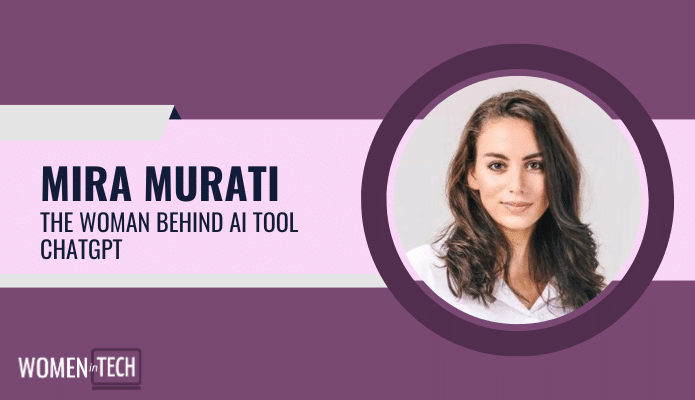Arguably the fastest-growing trend in technology in 2023 so far, artificial intelligence tools such as ChatGPT are taking over the internet. Giving users the functionality to have full conversations with a chatbot, ChatGPT is a natural language processing tool built and delivered by OpenAI, an American artificial intelligence research company. Heading up the company’s tech team is Mira Murati, the Chief Technology Officer, and perhaps the most trending woman in tech at the moment. In this article, we find out who Mira is, how ChatGPT’s software is changing the world we live in, and the uncertainties surrounding it.

Image from @miramurati on Twitter
What is OpenAI?
OpenAi is an independent not-for-profit research company who are focused on the advancement of artificial intelligence in a good and responsible way. AI as a science is surrounded by uncertainty and nervousness, as many people are worried about robots taking over and eradicating the need for human-powered jobs. However, artificial intelligence and machine learning have the capabilities to change the world for the better. Many of us don’t think we’re using AI in our everyday life, but from asking your smart speaker assistant to remind you to buy bread to spotify recommending you new music based on your previous listening, it’s already a solid addition to everything we do.
When it comes to OpenAI, their work is centralised around the idea of “advancing digital intelligence in the way that is most likely to benefit humanity as a whole.” It was founded in December 2015 by Elon Musk, Sam Altman, Greg Brockman, Wojciech Zaremba, Ilya Sutskever, and John Schulman, and has since created a number of innovative AI tools such as CodexAI and DALL·E 2. However, the company really took off when they introduced ChatGPT in November 2022.
Why is everyone talking about ChatGPT?
With artificial intelligence being shrouded in mystery, it’s no surprise that a tool as impressive as ChatGPT has gained such success. With more than one million users reported within just five days of the app launching, we’d be surprised if you haven’t seen it pop up on your feeds at some point. And the reason it’s got everyone talking? It shows the pure potential of machine-learning. From fixing problems in code, writing a university essay which gained a 2:2 from a professor, to coming up with a best man speech, the possibilities of ChatGPT really are endless.
Currently, the tool is still in its research & testing stage, so it’s free for anyone to use as they wish. ChatGPT isn’t perfect yet – it still makes mistakes. It relies on human input and feedback to learn and develop. However, since its release we’ve seen huge companies like Microsoft invest heavily in the software, so we should expect to see more machine learning tools coming into play in the near future.
Who is Mira Murati?
Currently, artificial intelligence is predominantly a male workforce, with only 22% of AI professionals being female. However, there are a few trailblazing women who are paving the way as role models for future generations of girls and women to join the machine learning world. Mira Murati is arguably one of the most influential of these women, with an impressive career to-date.
Murati was born in Albania in 1988 and, after moving to Canada at the age of 16, graduated with a degree in Mechanical Engineering from Thayer School of Engineering in 2012. Her first interest in AI came when she worked at Tesla. They were in their early release stages of the autopilot function on their cars, and this made Mira consider other possibilities for AI functionality in real-world applications. She then went on to work for another machine-learning startup called Leap Motion, working on an augmented reality software to replace keyboards. However, she decided that it wasn’t ready for a wider audience yet. Then came Murati’s move to OpenAI in 2018, where she helped launch Dall-E and ChatGPT.
At just 35 years old, Murati clearly has a hugely successful career ahead of her, with a roster of impressive companies on her CV. However, she’s not one to shout about her accomplishments. Mira rarely gives interviews, and her social media profiles are short and sweet. However, she’s very vocal about the need for governance of AI. Speaking to TIME earlier this year, she commented that “[AI] can be misused, or it can be used by bad actors. [..] It’s important for OpenAI and companies like ours to bring this into the public consciousness in a way that’s controlled and responsible. But we’re a small group of people and we need a ton more input in this system and a lot more input that goes beyond the technologies-—definitely regulators and governments and everyone else.”
What’s next for ChatGPT?
OpenAI recently announced that they’ve launched a major upgrade to ChatGPT called GPT-4. GPT-4 is a version of the ChatGPT platform which includes improvements that “exhibit human-level performance on various professional and academic benchmarks”. The upgraded software is only going to be available on a paid premium plan, for which there’s already a pretty long waiting list.
The future of ChatGPT’s research is unclear as an open letter has been drafted asking for a global pause on any further development past GPT-4. The letter has been signed by nearly 10,000 people so far, including Elon Musk and Steve Wozniak. The concerns in the letter are arguing that companies such as OpenAI, Microsoft and Google are entering a ‘race’ to build the most advanced AI technologies at an alarming pace. Goldman Sachs recently released a report which raised apprehensions as it stated that over 300 million full-time jobs could be threatened by technologies like ChatGPT. So it’s no surprise that there are calls for more regulations in the research into these technologies.
There’s no doubt that AI technologies are going to change the world we live in. However there are still so many uncertainties around just how far they can go. Companies like OpenAI with an ethos of creating safe AI tools to empower people, rather than eradicate the need for them, are arguably going to become the most powerful technology companies in the world. We’re so excited to see what they, and Mira Murati, do next. Watch this space!
Learn more about why there are so few women in Artificial Intelligence.






